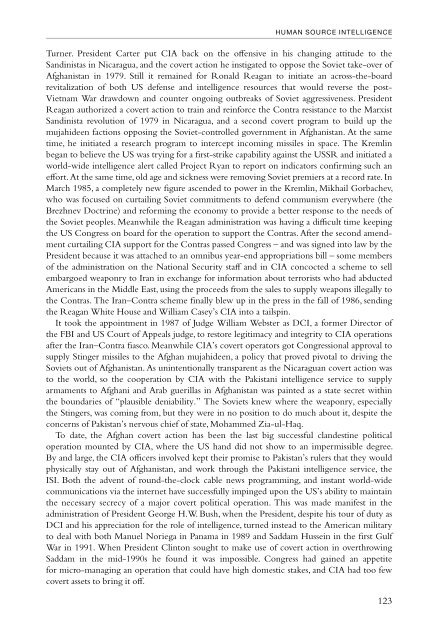Handbook of intelligence studies / edited by
Handbook of intelligence studies / edited by
Handbook of intelligence studies / edited by
Create successful ePaper yourself
Turn your PDF publications into a flip-book with our unique Google optimized e-Paper software.
HUMAN SOURCE INTELLIGENCE<br />
Turner. President Carter put CIA back on the <strong>of</strong>fensive in his changing attitude to the<br />
Sandinistas in Nicaragua, and the covert action he instigated to oppose the Soviet take-over <strong>of</strong><br />
Afghanistan in 1979. Still it remained for Ronald Reagan to initiate an across-the-board<br />
revitalization <strong>of</strong> both US defense and <strong>intelligence</strong> resources that would reverse the post-<br />
Vietnam War drawdown and counter ongoing outbreaks <strong>of</strong> Soviet aggressiveness. President<br />
Reagan authorized a covert action to train and reinforce the Contra resistance to the Marxist<br />
Sandinista revolution <strong>of</strong> 1979 in Nicaragua, and a second covert program to build up the<br />
mujahideen factions opposing the Soviet-controlled government in Afghanistan. At the same<br />
time, he initiated a research program to intercept incoming missiles in space. The Kremlin<br />
began to believe the US was trying for a first-strike capability against the USSR and initiated a<br />
world-wide <strong>intelligence</strong> alert called Project Ryan to report on indicators confirming such an<br />
effort. At the same time, old age and sickness were removing Soviet premiers at a record rate. In<br />
March 1985, a completely new figure ascended to power in the Kremlin, Mikhail Gorbachev,<br />
who was focused on curtailing Soviet commitments to defend communism everywhere (the<br />
Brezhnev Doctrine) and reforming the economy to provide a better response to the needs <strong>of</strong><br />
the Soviet peoples. Meanwhile the Reagan administration was having a difficult time keeping<br />
the US Congress on board for the operation to support the Contras. After the second amendment<br />
curtailing CIA support for the Contras passed Congress – and was signed into law <strong>by</strong> the<br />
President because it was attached to an omnibus year-end appropriations bill – some members<br />
<strong>of</strong> the administration on the National Security staff and in CIA concocted a scheme to sell<br />
embargoed weaponry to Iran in exchange for information about terrorists who had abducted<br />
Americans in the Middle East, using the proceeds from the sales to supply weapons illegally to<br />
the Contras. The Iran–Contra scheme finally blew up in the press in the fall <strong>of</strong> 1986, sending<br />
the Reagan White House and William Casey’s CIA into a tailspin.<br />
It took the appointment in 1987 <strong>of</strong> Judge William Webster as DCI, a former Director <strong>of</strong><br />
the FBI and US Court <strong>of</strong> Appeals judge, to restore legitimacy and integrity to CIA operations<br />
after the Iran–Contra fiasco. Meanwhile CIA’s covert operators got Congressional approval to<br />
supply Stinger missiles to the Afghan mujahideen, a policy that proved pivotal to driving the<br />
Soviets out <strong>of</strong> Afghanistan. As unintentionally transparent as the Nicaraguan covert action was<br />
to the world, so the cooperation <strong>by</strong> CIA with the Pakistani <strong>intelligence</strong> service to supply<br />
armaments to Afghani and Arab guerillas in Afghanistan was painted as a state secret within<br />
the boundaries <strong>of</strong> “plausible deniability.” The Soviets knew where the weaponry, especially<br />
the Stingers, was coming from, but they were in no position to do much about it, despite the<br />
concerns <strong>of</strong> Pakistan’s nervous chief <strong>of</strong> state, Mohammed Zia-ul-Haq.<br />
To date, the Afghan covert action has been the last big successful clandestine political<br />
operation mounted <strong>by</strong> CIA, where the US hand did not show to an impermissible degree.<br />
By and large, the CIA <strong>of</strong>ficers involved kept their promise to Pakistan’s rulers that they would<br />
physically stay out <strong>of</strong> Afghanistan, and work through the Pakistani <strong>intelligence</strong> service, the<br />
ISI. Both the advent <strong>of</strong> round-the-clock cable news programming, and instant world-wide<br />
communications via the internet have successfully impinged upon the US’s ability to maintain<br />
the necessary secrecy <strong>of</strong> a major covert political operation. This was made manifest in the<br />
administration <strong>of</strong> President George H.W. Bush, when the President, despite his tour <strong>of</strong> duty as<br />
DCI and his appreciation for the role <strong>of</strong> <strong>intelligence</strong>, turned instead to the American military<br />
to deal with both Manuel Noriega in Panama in 1989 and Saddam Hussein in the first Gulf<br />
War in 1991. When President Clinton sought to make use <strong>of</strong> covert action in overthrowing<br />
Saddam in the mid-1990s he found it was impossible. Congress had gained an appetite<br />
for micro-managing an operation that could have high domestic stakes, and CIA had too few<br />
covert assets to bring it <strong>of</strong>f.<br />
123
















